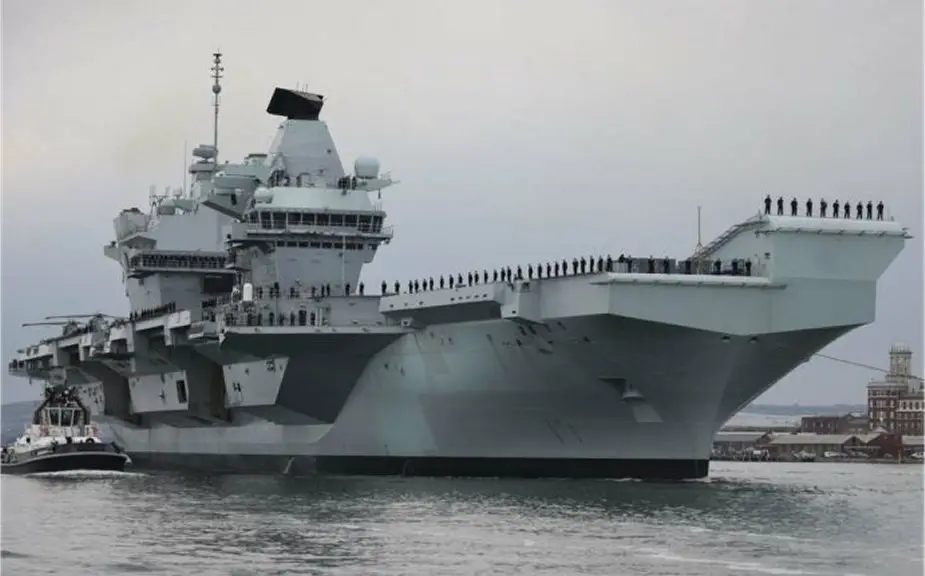Breaking news
Thales participation to UK CSG's international deployment.
As the Carrier Strike Group gets underway on its international deployment, it is only fitting that it should be led by one of the most distinctive and innovative warships in the world.
Follow Navy Recognition on Google News at this link
 Aircraft carrier HMS Queen Elizabeth (Picture source: Royal Navy)
Aircraft carrier HMS Queen Elizabeth (Picture source: Royal Navy)
HMS Queen Elizabeth, the most powerful surface vessel in the history of the Royal Navy, sets sail as the flagship of the largest concentration of UK maritime and air power in a generation, visiting more than 40 countries over the next six months.
Thales is proud to say we have been at the heart of the story of this remarkable ship from the very beginning and will be providing the critical eyes and ears capabilities of the accompanying surface, underwater and airborne assets – a partnership with the navy we can trace back over 100 years.
Today, almost every single submarine and surface ship in the fleet uses various combinations of our sonar, radar, communications, electro-optical systems and electronic warfare technology. Thousands of highly-skilled jobs at our sites across the UK and our supply chain have delivered the technology that will protect the CSG deployment.
Both HMS Queen Elizabeth and HMS Prince of Wales were built and delivered under a unique partnering relationship between Thales, BAE Systems, Babcock and the UK Ministry of Defence, in an enterprise known as the Aircraft Carrier Alliance.
Originally designed by Thales, the giant 65,000 tonne carrier has a unique twin island configuration, allowing the forward island to control and navigate the ship while the rear island can control and operate the fast jet and helicopters deployed on board.
Due to its innovative design and use of automation, the ship’s company numbers just 700, increasing to around 1,600 when a full complement of F-35B jets and Merlin helicopters are embarked. Compare this to other similar-sized carriers from other navies that have crews of 2,000 and more.
The Thales contribution to the ship has been nationwide – Thales’s Bristol-based office became a critical part of the programme, with around 200 alliance engineers responsible for the naval architecture, design and power and propulsion for these two mighty vessels.
The voice of the ship comes from our state-of-the-art naval communications facilities at Crawley in West Sussex, enabling critical comms with the crew, aircraft and other ships. A recent extensive naval communications upgrade has established an additional command operations centre on board to direct wider task group operations.
On top of the forward island is the S1850M radar, developed by our colleagues in the Netherlands, providing the ship with critical long range cover and capable of automatic detection and tracking of up to 1000 air targets, up to a range of 400km. It can spot a golf ball sized object from 60 km away.
At Templecombe in Somerset and Cheadle Heath near Manchester, Thales engineers have provided the ships and submarine with critical sonar systems to detect underwater threats. Merlin helicopters fitted with Thales FLASH-dipping sonar will work with anti-submarine warfare frigates fitted with Thales Sonar 2087 to keep the seas clear of submarines.
Threat-sensing electronic warfare from Crawley protects the ring of warships around the flagship.
Under the waves, the Astute submarine – the most advanced hunter-killer submarine in its class – operates with our eyes and ears provided by Sonar 2076 from Templecombe and Cheadle and an optronic mast from Glasgow. Since 1917, every single Royal Navy submarine has operated with a periscope or optronic mast designed and manufactured by our engineers in Scotland.
In the air, Merlin helicopters fitted with the new Crowsnest system from Crawley will help protect the carrier with airborne surveillance and the control. Wildcat helicopters fitted with the LMM missile system from Belfast will provide a formidable line of defence.
The HMS Queen Elizabeth is the first of the two Queen Elizabeth class aircraft carriers in service with the British Navy. The ship began sea trials in June 2017, was commissioned on 7 December 2017 and entered service with the British Navy in 2020.


























